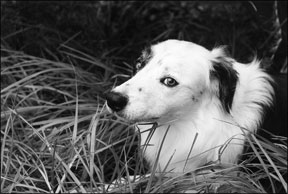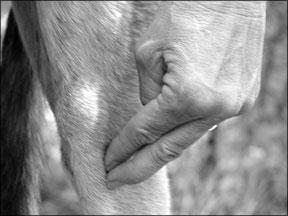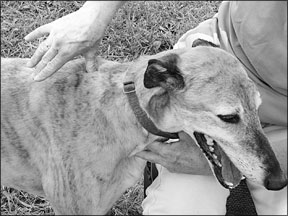Does a worried dog sing a worried song? A dog’s worried “song” is often expressed in quirky, repetitive behaviors and anxiety disorders known as Canine Compulsive Disorder (CCD).
A dog with CCD does more than exhibit anxiety in the face of an immediate threat; he often compulsively repeats a behavior that has nothing to do with escaping a danger or trigger. This is an excessive response; this level of worry is beyond immediate survival and, ironically, often results in the dog causing himself harm.
Dogs with CCD commonly exhibit behaviors such as licking their forelegs incessantly, chasing their tails or spinning in circles, monotonous barking, air-snapping, nail or foot chewing, sucking on the flank, ingesting nonfood objects, over-drinking water, and other repetitive behaviors. These behaviors may appear to have no immediate causation, though they may serve to relieve the dogs’ anxieties.

The first order of business for a dog exhibiting signs of CCD is to have a complete examination by a holistic veterinarian. If the vet determines that there is no medical condition underlying the repetitive behavior, review the dog’s environment and lifestyle. Consider the breed. Some breeds are genetically predisposed to particular manifestations of CCD. For example, herding breeds often find odd things to chase or nip at (including shadows, rays of light, flies, or dust motes), while retrieving breeds may compulsively mouth or suck toys or blankets.
Dogs who are kenneled or kept indoors many hours a day can become frustrated from lack of exercise and stimulation, and have a higher possibility of developing CCD. Confinement is probably one of the greatest contributors to CCD. Dogs are not loners; being left alone for long periods of time can cause the type of stress that leads to anxiety disorders. Animals exposed to consistent conflict or stress within a household often exhibit repetitive behaviors.
Knowing the genesis of the behavior helps to determine how to approach resolving CCD. Sometimes it is as simple as realizing that the dog is inadvertently being rewarded for an unwanted repetitive behavior, such as hyper-jumping, when all the dog really needs is attention. Providing the dog with direction and positive reinforcement for appropriate behavior can go a long way in resolving a number of problem behaviors. Punishment rarely extinguishes canine behaviors associated with CCD; in fact, punishing the animal usually causes further stress.
Combine OCD Treatments
There are many alternatives to pharmaceutical approaches to help a dog overcome CCD. Acupressure is known to reduce the dog’s stress level while simultaneously establishing new energetic patterns that can support behavior change. Consulting a professional trainer to help design a behavior modification program can be helpful. There are also homeopathic, herbal, essential oil, and flower essence remedies available to support a dog who is contending with long-term stressors resulting in compulsive behaviors.

The most effective approach to working with CCD is usually a combined approach. Acupressure offers the benefit of enhancing the effectiveness of behavior modification, herbal, and other remedies. Acupressure is based on the principals of Traditional Chinese Medicine (TCM). From the TCM perspective, the extremely deep level of worry that underlies CCD indicates a disturbance of the animal’s spirit and sense that his basic needs are not being met.
When a dog is highly frustrated or conflicted for an extended period, his anxiety builds and his concern for his very survival increases. To relieve this anxiety, he may repetitively lick his foreleg until it is raw or chew his own paw two very common expressions of anxiety. If an animal hurts himself, we know that his spirit has been seriously injured and his sense of security on earth is deeply threatened.
Acupressure Point Selection
There are specific acupressure points pools of energy on the dog’s body that can be stimulated to relieve a dog’s anxiety and support his self-confidence and sense of security.

The following acupressure points (also called “acupoints”) can be used to calm the spirit by relieving anxiety, stress, and worry while also addressing behavior problems and hyperactivity: Conception Vessel 14 (CV14), Governing Vessel 20 (GV 20), and Heart 7 (HT 7).
In addition, Stomach 45 (ST 45) and Spleen 1 (SP 1) can be used to promote the dog’s “grounding” and sense of belonging while also calming his spirit, clearing his mind, and resolving depression.
Acupressure Point Work Techniques
Each of the acupoints mentioned and identified in the chart below are bilateral; they are located on and should be addressed on both sides of the dog’s body.
Place the soft, fleshy portion of the tip of your thumb on the point and press down gently yet with intention. Count slowly to 30 while applying pressure or until the dog shows that he has experienced an energy release, by yawning, licking, stretching, rolling over, passing gas, or moving away. Then move to the next acupoint.
Another point work technique, which can be used especially if you want to increase the dog’s energy (if he seems depressed or lethargic), is to use your index and middle finger to scratch the acupoint. Again, count to 30 slowly or move to the next point when the dog indicates he has released the energy from the point.
While you hold each acupoint, think about how much you love the dog and want to meet his needs so that he will feel secure and he can let go of all his earthly worries.
Repeating this acupressure session every three or four days for four to six weeks will help the dog feel more comfortable and relaxed, especially if the other environmental, lifestyle, and social issues have been resolved.
Amy Snow and Nancy Zidonis are the authors of The Well-ConnectedDog: A Guide to Canine Acupressure, Acu-Cat: A Guide to FelineAcupressure, and Equine Acupressure: A Working Manual. Theyfounded Tallgrass Animal Acupressure Institute, which offers apractitioner certificate program and training programs worldwide,plus books, meridian charts, and videos. Contact them or purchasethese products at (888) 841-7211 or animalacupressure.com.





